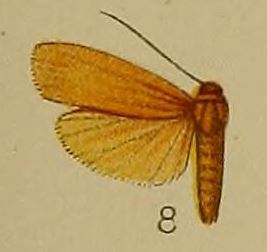
Brunia is a genus of tiger moths in the family Erebidae. The genus was described by Moore in 1878.

Brunia antica is a moth of the family Erebidae described by Francis Walker in 1854. It is found from the Indian subregion, Sri Lanka to China, the Ryukyu Islands, the Chagos Archipelago, the Nicobar Islands and Sundaland.

Agostino Brunias was a London-based Italian painter from Rome. Strongly associated with West Indian art, he left England at the height of his career to chronicle Dominica and the neighboring islands of the Lesser Antilles.

Manulea replana, the lichen-eating caterpillar or lichen moth, is a species of moth of the subfamily Arctiinae. It is found in Australia.

Brunia dorsalis is a species of moth of the family Erebidae. It was described by Francis Walker in 1866. It is found in the Northern Territory, Queensland, the Sula Islands, the Louisiade Archipelago and New Guinea.
Brunia ekeikei is a moth of the family Erebidae. It was described by George Thomas Bethune-Baker in 1904. It is found in New Guinea.
Brunia apicalis is a moth of the family Erebidae. It was described by Francis Walker in 1862. It is found on Borneo. The habitat consists of forests, ranging from lowlands to 1,200 meters.
Brunia cucullata is a moth of the family Erebidae. It was described by Moore in 1878. It is found on the Andamans.
Brunia gibonica is a moth of the family Erebidae. It was described by Karel Černý in 2009. It is found in Thailand and southern Vietnam.
Brunia lacrima is a moth of the family Erebidae. It was described by Karel Černý in 2009. It is found in Thailand and southern Vietnam.
Brunia nebulifera is a moth of the family Erebidae. It was described by George Hampson in 1900. It is found on Borneo and in Singapore. The habitat consists of lowland forests, including lowland dipterocarp forests, mangroves and disturbed areas.
Brunia sarawaca is a moth of the family Erebidae. It was described by Arthur Gardiner Butler in 1877. It is found on Borneo, Peninsular Malaysia, Java and the north-eastern Himalayas. The habitat consists of lowland forests.
Brunia testacea is a moth of the family Erebidae. It was described by Rothschild in 1912. It is found on the Solomon Islands.
Ovenna vicaria, the ubiquitous footman, is a moth of the subfamily Arctiinae. It was described by Francis Walker in 1854. It is found in Africa, where it has been recorded from Angola, Cameroon, the Republic of the Congo, the Democratic Republic of the Congo, Guinea, Lesotho, Malawi, Mozambique, Nigeria, South Africa, Uganda and Zambia. Records from the Oriental region refer to Brunia antica.
Eilema pseudosimplex is a moth of the subfamily Arctiinae. It was described by Hervé de Toulgoët in 1977. It is found in Kenya and Rwanda.
Eilema sokotrensis is a moth of the subfamily Arctiinae. It was described by George Hampson in 1900. It is found in Yemen.
Archithosia rhyparodactyla is a moth of the subfamily Arctiinae. It was described by Sergius G. Kiriakoff in 1963. It is found in the Democratic Republic of the Congo.
Pusiola melemona is a moth in the subfamily Arctiinae. It was described by Sergius G. Kiriakoff in 1963. It is found in the Democratic Republic of the Congo.
The Lithosiina are a subtribe of lichen moths in the family Erebidae. The taxon was erected by Gustaf Johan Billberg in 1820.


